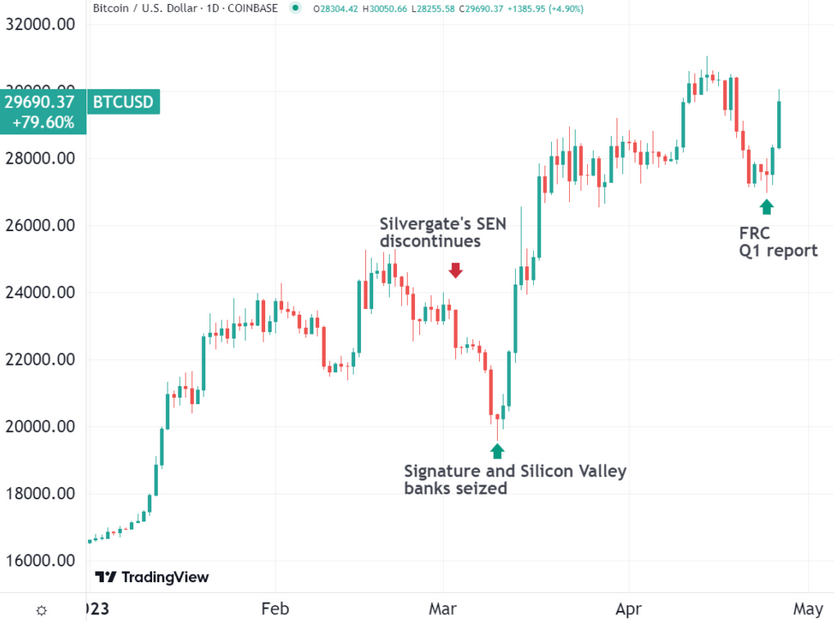Cryptos are red hot again. Bitcoin is up almost 70% year to date, and reports of the crypto king breaching $100,000 by 2024 have grabbed the headlines again. This is exactly what investors were hoping for after a dismal 2022, when the cryptocurrency market cap declined below $800 billion. This phenomenal revival has put an end to discussions of another crypto winter (after the 23-month long one from 2018-2020). After all, the crypto market cap sits comfortable above $1 trillion now.
Why did Bitcoin breach $30,000 in April? What made Ethereum rise back above $2,000? Here’s a look at the reasons for the bullish sentiment and where it might take digital currencies through 2023.
The MiCA Approval
On October 5, 2022, the proposal of Markets in Crypto-Assets (MiCA) regulation was approved by the European Council. The European parliament voted in favour of the new framework on April 19, 2023. The guidelines intend to facilitate crypto services and exchanges across the Eurozone. This is set to provide more credibility and legitimacy to cryptocurrencies in the region. The attempts by the EU to regulate the crypto market to protect investors and support a “future-ready economy,” are a major force driving crypto-optimism in the region. The acknowledgment and inclusion of asset-referenced and electronic money tokens (ARTs and EMTs) in the framework are helping push the demand for altcoins.

Trust from Major Players
Despite a cold 2022, most institutional supporters have maintained their stance and have mentioned, on multiple occasions, that cryptocurrencies will rebound sooner than expected. Michael Saylor of Microstrategy, for instance, has been consistently expressing his optimism toward decentralised coins. Elon Musk’s affinity to Dogecoin isn’t hidden from anyone, and his latest “prank,” changing the Twitter bird to the Doge Shiba Inu dog just confirmed that. Moreover, blue-chip companies, such as Alphabet, Black Rock and Mastercard have also expressed plans to offer crypto payments to their customers and are accumulating digital assets.

Impending BTC Halving
Bitcoin prices have historically surged after the production per block is halved. As the next halving comes closer, investors have started accumulating the pioneering cryptocurrency to maximise their gains post the halving event, scheduled for April-May 2024. The crypto trading community awaits the period of mini-bull runs around crypto having to take advantage of multiple opportunities it may bring.
So, 2023 marks the accumulation phase of the BTC cycle, which comes before the climbing phase. With 45.49% crypto market dominance, Bitcoin impacts and benchmarks the general sentiment toward cryptocurrencies, which usually provides tailwinds for the overall digital currency market.
Banking Crisis in the US
Over a short span of 10 days, the US banking system lost consumer confidence. Credit Suisse echoed the US crisis. While investors were still digesting news of Silvergate Capital winding up, Silicon Valley Bank (SVB) announced plans to sell $2.25 billion in common equity. Amid the collapse of the so-called “fail-proof” banks, a spurt of increased emergency demand began from many others. First Republic Bank would have joined the list of bank failures if it hadn’t been for JPMorgan and other major banks coming together to pump more than $30 billion into its liquidity-devoid vault.
Cryptos are the flagbearers of decentralised ownership and complete authority over one’s assets. Specifically, retail investors started looking towards a trustless economy as confidence in fiat declined, helping raise the demand for cryptocurrencies.

Crypto – The Talk of the Year at the G20
Since India took the G20 chair, a global policy for regulating cryptocurrencies has been on the agenda. It remained the focal point at both the meetings of the Finance Ministers and Central Bank Governors this year. The reiteration of maintaining the potential benefits of digital currencies while protecting global economies from any harm, in a discussion between the IMF (International Monetary Fund), BIS (Bank of International Settlements), FATF (Financial Action Task Force) and G20 members, is helping crypto optimism.
It is a sign that regulatory bodies across the globe are working towards developing a framework for traditional and digital economies to work cohesively without damaging one another. The effort by various governments to prevent any macroeconomic damage from virtual currencies is helping boost the credibility of the crypto sector. This widespread adoption of cryptos has exerted upward pressure on the crypto market.
The Way Forward (or Upward?)
U0Today suggests that Bitcoin is nearing an inflection point, a trend that is being witnessed across the crypto market. It mentions that a stunning rally is followed by a deeper decline. However, a report by CNBC suggests that Bitcoin typically climbs after 50% of investors have portfolios in the red. Based on this, the November bottom could be the key inflection point and now digital assets could break new records. Additionally, expectations of the approval of the first Bitcoin spot ETF in the US suggests a strengthening belief in digital currencies.
Enhanced confidence in decentralised finance and Web-3 technologies may push the demand for cryptocurrencies or any other form of decentralised economy. However, we suggest crypto trading be done only after due diligence. Cryptocurrencies are extremely volatile. Protecting your money from the associated risks is your responsibility – #YMYL. However, in the digital age of managing finances, we believe a balanced portfolio needs some room for cryptocurrencies. But again, it is your money and your life, evaluate your risk appetite and make your call.


Leave A Comment
You must be logged in to post a comment.